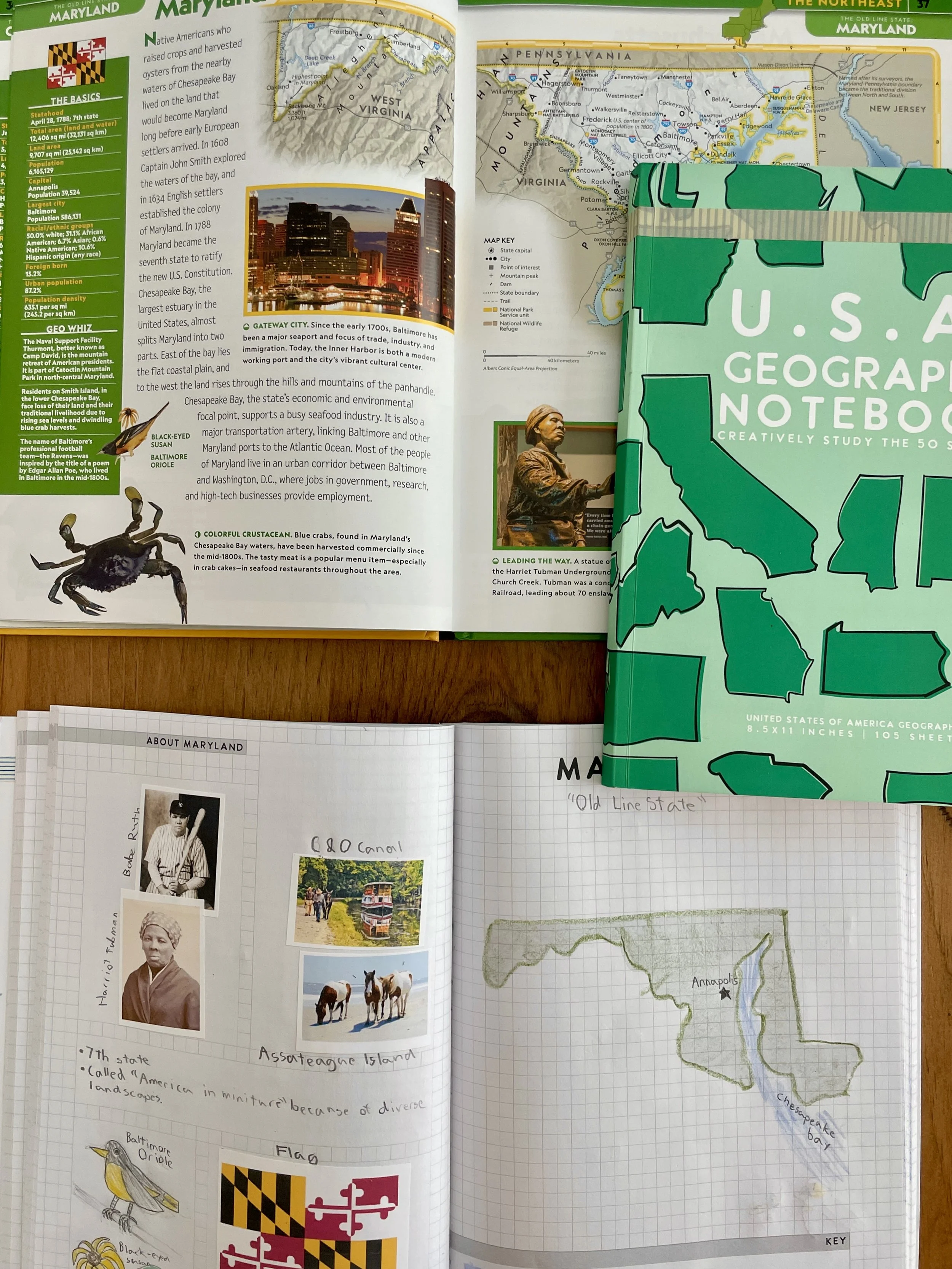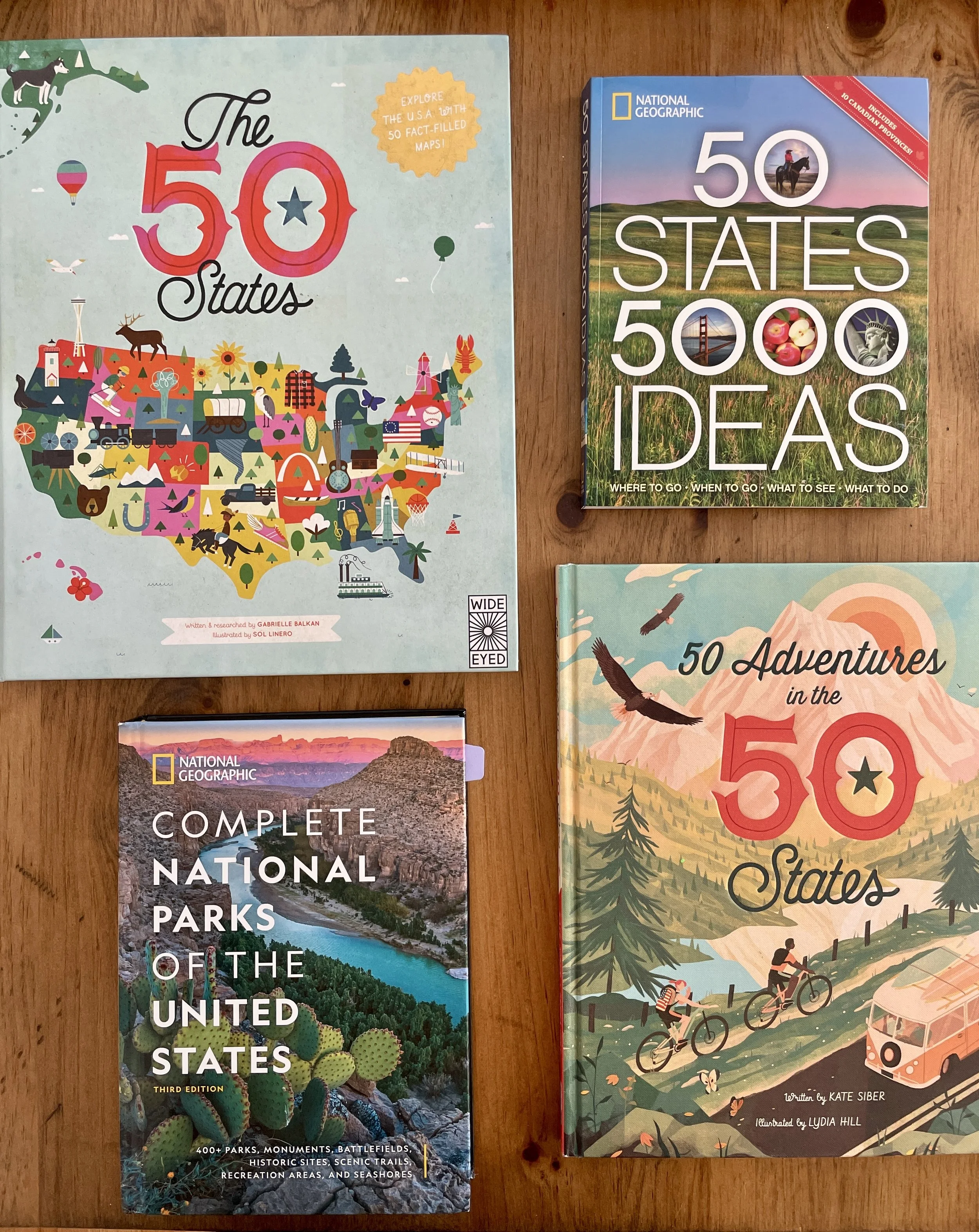Teaching U.S. Geography in Our Homeschool: One State at a Time
When we started planning our two-year American history study, I knew I wanted to integrate U.S. geography in a meaningful, engaging way. Instead of rushing through all 50 states in a single year, we decided to slow down and focus on one state per week, stretching our geography study over two years. This approach gives my kids time to truly absorb and connect with each state's unique geography, history, and culture.
Why Teach U.S. Geography?
Geography is so much more than memorizing state capitals and coloring in maps (although, let’s be honest, my kids love a good map activity). It helps kids understand how location shapes history, how geography influences culture, and how different regions of the U.S. connect. It also builds map skills, spatial awareness, and a greater appreciation for the diversity of landscapes and communities across our country.
Plus, by weaving geography into our American history study, my kids are naturally making connections between where events happened and why they mattered. Instead of learning about history in isolation, they can see how the land itself played a role in shaping our nation’s story.
Our U.S. Geography Resources
We’re using a mix of spine books, supplemental books, games, and hands-on activities to keep things engaging and multi-sensory. Here’s what’s in our lineup:
Spine Resources
National Geographic Kids U.S. Atlas – A colorful, engaging atlas packed with facts, maps, and photos.
Schoolnest U.S. Geography Notebooks – The heart of our geography study! These journals provide a structured way to document what we learn about each state.
Additional Book Resources
The 50 States: Explore the USA – Beautiful illustrations and fun tidbits about each state.
50 Adventures in the 50 States – Highlights unique outdoor experiences in each state.
50 States, 5000 Ideas – A travel-style book from National Geographic that adds real-world connections.
Complete National Parks of the United States – A great way to incorporate the beauty and significance of our national parks.
Additional Resources
Scrambled States of America (Game) – A silly but educational way to reinforce state locations.
Game of the States – Teaches geography, state trivia, and basic economics.
USA Puzzle – A hands-on way to reinforce state shapes and locations.
USA Tracing Board Map (by Treasures From Jennifer) – A Montessori-inspired wooden map for tracing state outlines.
U.S. Map of Native American Indian Tribes & Linguistic Stocks (1650) – A historical map helping us explore the Indigenous Nations that originally inhabited each state.
Multimedia & Virtual Learning
YouTube videos about each state
Virtual tours of states — I search the state and look for vlogger’s who have videos. There are some pretty paid AI videos now, so definitely preview them
Homeschool Pop has state videos, but they are incredibly cheesy and my kids are not a fan.
Virtual tours of key landmarks and national parks
Sparkle Stories’ "Fifty: The Stars, the States, and the Stories" – A storytelling approach to U.S. geography
Our Weekly U.S. Geography Routine
We keep our geography study simple but structured, focusing on one state per week. Here’s our general plan:
Day 1: Introduction
Locate the state on our map
Watch introductory videos
Read about the state in our Nat Geo Kids Atlas
Day 2: Digging Deeper
Read more from our supplemental books
Watch more videos or a virtual tour
Day 3: Map Work
Complete map activities in our Schoolnest journals
Label major cities, rivers, and landmarks
Day 4: Journal & Creative Work
Add stickers for the flag, landmarks, and famous people
Draw the state bird and flower
My 10-year-old writes three state facts and the motto
My 8-year-old writes the state motto
Ongoing: Learning About Indigenous Nations
As part of our geography study, we’re also exploring the Indigenous Nations that originally lived in each state. Using the U.S. Map of Native American Indian Tribes & Linguistic Stocks (1650), we look up the names, cultures, and histories of the Native peoples from each region. We discuss their impact on the land, their traditions, and how many of these Nations still exist today. This adds an important layer of depth to our study, helping my kids see that the history of each state didn’t begin with European settlement.
Ongoing: General Geography Work
In between state studies, we’re weaving in broader geography concepts using a Teachers Pay Teachers packet:
United States Geography: US Regions Interactive Notebook.
This helps us cover topics like landforms, climate, time zones, and regions while reinforcing map skills.
Making Geography Fun and Memorable
The best part about this plan? It’s engaging, flexible, and fun! Some weeks, we might add in a recipe from the state we’re studying, explore a famous figure, or dive deeper into a national park. Other weeks, we might keep it simple with just books and videos.
By the end of two years, my kids won’t just be able to point out states on a map—they’ll have a deep, personal connection to the geography of their country. And really, that’s the goal: to make learning feel alive, connected, and full of adventure.
Are you teaching U.S. geography in your homeschool? What are your favorite resources or activities? Let’s chat in the comments!





